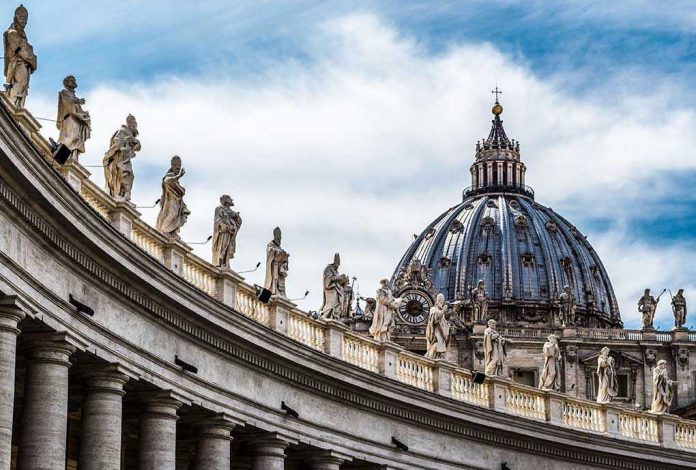
When a man urinated on the holiest altar at St. Peter’s Basilica, he didn’t just desecrate a sacred site—he forced the world to confront the growing vulnerability of religious symbols in an era of public protest and spiritual unrest.
Story Highlights
- Desecration struck the Altar of Confession at St. Peter’s Basilica during Holy Mass, witnessed by hundreds.
- This incident is part of a disturbing pattern of attacks targeting Christian sacred spaces in recent years.
- The Vatican faces mounting pressure to balance openness with security and spiritual integrity.
- Global religious institutions may need new strategies to protect their sites and communities.
Desecration at the Heart of Catholicism: A Scene Unfolds
Hundreds of worshippers gather beneath Michelangelo’s dome as Holy Mass proceeds at St. Peter’s Basilica. In a jolt that reverberates through the crowd, a man climbs onto the Altar of Confession—just steps from the tomb of the Apostle Peter, the spiritual anchor of Catholicism. Before stunned eyes, he urinates on the altar, shattering the sanctity of a space used by Popes for centuries. Vatican police rush to detain him, but the damage is done: the visible breach of sacred boundaries leaves clergy and faithful shaken.
Immediate arrest by plainclothes officers follows, but questions spiral. Who is this man? What drives someone to such a public act of sacrilege? Authorities remain silent on his identity and motives, fueling speculation—was it a targeted protest, a sign of mental distress, or a manifestation of deeper animosity toward religion? The altar, a symbol of continuity from St. Peter to the present day, now requires a penitential rite to restore its spiritual integrity.
Patterns of Hostility: The Altar Under Siege
This isn’t the first attack on the Altar of Confession. Earlier in 2025, a man shattered candelabras on the same altar, and in 2023, a Polish protestor stripped naked atop it, “Save children of Ukraine” scrawled across his back. Each incident demanded ritual re-sanctification, reinforcing the altar’s symbolic vulnerability. St. Peter’s Basilica, the world’s spiritual epicenter for millions, has become a stage for acts that blur the line between protest and desecration. These events reflect a wider trend—churches and Christian symbols across continents increasingly targeted in political, social, or personal disputes.
🚨 Breaking news
Shock at St. Peter’s Basilica, Vatican City 🇻🇦
Man urinates at the Altar of the Confession in front of worshippers and touristshttps://t.co/9xXb0G4wbL
— Mambo Italiano (@mamboitaliano__) October 11, 2025
For Vatican leadership, these attacks pose a dilemma. The basilica stands as a beacon of openness, welcoming pilgrims and tourists, but such openness now collides with the imperative for security. Senior clergy and Vatican officials must weigh the cost of heightened surveillance against the ideal of spiritual hospitality. The power dynamics are clear: Vatican police enforce order, but it’s the church leadership that shapes the public and internal narrative, deciding how the faithful—and the world—will interpret these assaults.
Immediate and Lasting Consequences: Faith, Fear, and Response
Shock waves ripple outward from the basilica. Worshippers and clergy face both immediate disruption and lingering unease. The need for penitential rites interrupts the rhythm of religious services, and the psychological impact—fear that sacred spaces are no longer inviolable—settles in. Vatican staff and security scramble to review protocols, likely considering stricter access controls and surveillance upgrades.
The broader Christian community senses a threat not just to buildings but to the idea of spiritual refuge itself. Political and social ramifications emerge: debates over religious respect, mental health, and the boundaries of protest intensify. The Vatican may face increased pressure to articulate its response, balancing compassion for possible mental illness with a firm stance on religious sanctity. Other global religious institutions, watching events unfold, may revisit their own crisis plans, recognizing that no sanctuary is immune from disruption in an era of public spectacle.
Expert Perspectives: Hostility, Security, and the Future of Sacred Spaces
Commentators identify a “growing pattern of hostility toward churches and Christian symbols,” with acts of vandalism and protest now a frequent feature in headlines. This latest desecration, covered by mainstream and Catholic outlets alike, is treated not as an isolated incident but as a symptom of shifting social attitudes. Some analysts link these attacks to broader cultural tensions—a decline in respect for religious institutions, a surge in public protest, and gaps in mental health support.
Others point to the symbolic importance of the altar: desecrating such a site wounds not only the immediate community but the collective identity of millions. For American conservatives and anyone who values tradition, the event underscores the need for common sense security and a renewed emphasis on religious tolerance. The Vatican’s challenge isn’t just restoring a marble altar; it’s restoring faith in the idea that sacred places can still mean something in the public square.
Sources:
Christian Warrior Training: Desecration in Vatican: Man Urinates on Altar in Broad Daylight
EWTN Vatican: St. Peter’s Basilica Altar Desecration 2025









